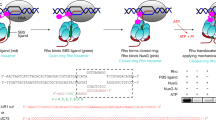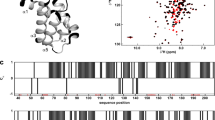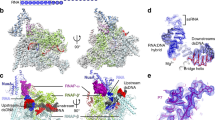Abstract
HutP regulates the expression of the hut structural genes of Bacillus subtilis by an anti-termination mechanism and requires two components, Mg2+ ions and l-histidine. HutP recognizes three UAG triplet units, separated by four non-conserved nucleotides on the terminator region. Here we report the 1.60-Å resolution crystal structure of the quaternary complex (HutP–l-histidine–Mg2+–21-base single-stranded RNA). In the complex, the RNA adopts a novel triangular fold on the hexameric surface of HutP, without any base-pairing, and binds to the protein mostly by specific protein–base interactions. The structure explains how the HutP and RNA interactions are regulated critically by the l-histidine and Mg2+ ion through the structural rearrangement. To gain insights into these structural rearrangements, we solved two additional crystal structures (uncomplexed HutP and HutP–l-histidine–Mg2+) that revealed the intermediate structures of HutP (before forming an active structure) and the importance of the Mg2+ ion interactions in the complexes.
This is a preview of subscription content, access via your institution
Access options
Subscribe to this journal
Receive 51 print issues and online access
$199.00 per year
only $3.90 per issue
Buy this article
- Purchase on Springer Link
- Instant access to full article PDF
Prices may be subject to local taxes which are calculated during checkout





Similar content being viewed by others
References
Chasin, L. A. & Magasanik, B. Induction and repression of the histidine-degrading enzymes of Bacillus subtilis. J. Biol. Chem. 243, 5165–5178 (1968)
Kimmhi, Y. & Magasanik, B. Genetic basis of histidine degradation in Bacillus subtilis. J. Biol. Chem. 245, 3545–3548 (1970)
Oda, M., Sugishita, A. & Furukawa, K. Cloning and nucleotide sequences of histidase and regulatory genes in the Bacillus subtilis hut operon and positive regulation of the operon. J. Bacteriol. 170, 3199–3205 (1988)
Wray, L. V. Jr & Fisher, S. H. Analysis of Bacillus subtilis hut operon expression indicates that histidine-dependent induction is mediated primarily by transcriptional anti-termination and that amino acid repression is mediated by two mechanisms: regulation of transcription initiation and inhibition of histidine transport. J. Bacteriol. 176, 5466–5473 (1994)
Oda, M., Kobayashi, N., Ito, A., Kurusu, Y. & Taira, K. Cis-acting regulatory sequences for anti-termination in the transcript of the Bacillus subtilis hut operon and histidine-dependent binding of HutP to the transcript containing the regulatory sequences. Mol. Microbiol. 35, 1244–1254 (2000)
Yanofsky, C. Advancing our knowledge in biochemistry, genetics, and microbiology through studies on tryptophan metabolism. Annu. Rev. Biochem. 70, 1–37 (2001)
Gollnick, P. & Babitzke, P. Transcription attenuation. Biochim. Biophys. Acta 1577, 240–245 (2002)
Stulke, J. Control of transcription termination in bacteria by RNA-binding proteins that modulate RNA structures. Arch. Microbiol. 177, 433–440 (2002)
Houman, F., Diaz-Torres, M. R. & Wright, A. Transcriptional anti-termination in the bgl operon of E. coli is modulated by a specific RNA binding protein. Cell 62, 1153–1163 (1990)
Aymerich, S. & Stenmetz, M. Specificity determinants and structural features in the RNA target of the bacterial anti-terminator proteins of the BgiG/SacY family. Proc. Natl Acad. Sci. USA 89, 10410–10414 (1992)
Babitzke, P. & Yanofsky, C. Reconstitution of Bacillus subtilis trp attenuation in vitro with TRAP, the trp RNA-binding attenuation protein. Proc. Natl Acad. Sci. USA 90, 133–137 (1993)
Arnaud, M. D., Debarbouille, M., Rapoport, G., Saier, M. H. Jr & Reizer, J. In vitro reconstitution of transcriptional attenuation by the SacT and SacY proteins of Bacillus subtilis. J. Biol. Chem. 271, 18966–18972 (1996)
Lu, Y., Turner, R. J. & Switzer, R. L. Function of RNA secondary structures in transcriptional attenuation of the Bacillus subtilis pyr operon. Proc. Natl Acad. Sci. USA 93, 14462–14467 (1996)
Alpert, C. A. & Siebers, U. The lac operon of Lactobacillus casei contains lacT, a gene coding for a protein of the Bg1G family of transcriptional anti-terminators. J. Bacteriol. 179, 1555–1562 (1997)
Glatz, E., Nilsson, R. P., Rutberg, L. & Rutberg, B. A dual role for the Bacillus subtilis glpD leader and the GlpP protein in the regulated expression of glpD: anti-termination and control of mRNA stability. Mol. Microbiol. 19, 319–328 (1996)
Kumarevel, T. S. et al. Crystal structure of activated HutP: an RNA binding protein that regulates hut operon in Bacillus subtilis. Structure 12, 1269–1280 (2004)
Kumarevel, T. S., Mizuno, H. & Kumar, P. K. R. Allosteric activation of HutP protein, that regulates transcription of hut operon in Bacillus subtilis, mediated by various analogs of histidine. Nucleic Acids Res. Suppl. 3, 199–200 (2003)
Kumarevel, T. S., Gopinath, S. C. B., Mizuno, H. & Kumar, P. K. R. Identification of important chemical groups of the hut mRNA for HutP interactions that regulates the hut operon in Bacillus subtilis. Nucleic Acids Res. 32, 3904–3912 (2004)
Read, T. D. et al. The genome sequence of Bacillus anthracis Ames and comparison to closely related bacteria. Nature 423, 81–86 (2003)
Ivanova, N. et al. Genome sequence of Bacillus cereus and comparative analysis with Bacillus anthracis. Nature 423, 87–91 (2003)
Takami, H. et al. Complete genome sequence of the alkaliphilic bacterium Bacillus halodurans and genomic sequence comparison with Bacillus subtilis. Nucleic Acids Res. 28, 4317–4331 (2000)
Antson, A. A. et al. Structure of the trp RNA-binding attenuation protein, TRAP, bound to RNA. Nature 401, 235–242 (1999)
Yang, Y., Declerck, N., Manivel, X., Aymerich, S. & Kochoyan, M. Solution structure of the LicT-RNA anti-termination complex: CAT clamping RAT. EMBO J. 21, 1987–1997 (2002)
Wimberly, B. T., Guymon, R., McCutcheon, J. P., White, S. W. & Ramakrishnan, V. A detailed view of a ribosomal active site: The structure of the L11–RNA complex. Cell 97, 491–502 (1999)
Deo, R. C., Bonanno, J. B., Sonenberg, N. & Burely, S. K. Recognition of polyadenylate RNA by the poly(A)-binding protein. Cell 98, 835–845 (1999)
Handa, N. et al. Structural basis for recognition of the tra mRNA precursor by the Sex-lethal protein. Nature 398, 579–585 (1999)
Liu, Z. et al. Structural basis for recognition of the intron branch site RNA by splicing factor 1. Science 294, 1098–1102 (2001)
Lewis, H. A. et al. Sequence-specific RNA binding by a Nova KH domain: implications for paraneoplastic disease and fragile X syndrome. Cell 100, 323–332 (2000)
Bogden, C. E., Fass, D., Bergman, N., Nichols, M. D. & Berger, J. M. Structural basis for terminator recognition by the Rho transcription termination factor. Mol. Cell 3, 487–493 (1999)
Thore, S., Mayes, C., Sauter, C., Weeks, S. & Suck, D. Crystal structures of the Pyrococcus abyssi Sm core and its complex with RNA. Common features of RNA binding in Archaea and Eukarya. J. Biol. Chem. 278, 1239–1247 (2003)
Nagai, K., Outbridge, C., Jessen, T. H., Li, J. & Evans, P. R. Crystal structure of the RNA-binding domain of the U1 small nuclear ribonucleoprotein A. Nature 348, 515–520 (1990)
Kumarevel, T. S. et al. Crystallization and preliminary X-ray diffraction studies of HutP protein: an RNA binding protein that regulates the transcription of hut operon in Bacillus subtilis. J. Struct. Biol. 138, 237–240 (2002)
Otwinowski, Z. & Minor, W. Processing of X-ray diffraction data collected in oscillation model. Methods Enzymol. 276, 307–326 (1997)
Brunger, A. et al. Crystallography and NMR system: a new software system for macromolecular structure determination. Acta Crystallogr. D 54, 905–921 (1998)
Oldfield, T. J. A number of real-space torsion-angle refinement techniques for proteins, nucleic acids, ligands and solvent. Acta Crystallogr. D 57, 82–94 (2001)
Carson, M. Ribbons. Methods Enzymol. 277, 493–505 (1997)
Nicholls, A., Sharp, K. A. & Honig, B. Protein folding and association: insights from the interfacial and thermodynamic properties of hydrocarbons. Proteins 11, 281–296 (1991)
Kraulis, P. J. Molscript: a program to produce both detailed and schematic plots of protein structures. J. Appl. Crystallogr. 24, 946–950 (1991)
Merritt, E. A. & Bacon, D. J. Raster3D photorealistic molecular graphics. Methods Enzymol. 277, 505–524 (1997)
Acknowledgements
We thank the personnel at beamline AR-NW12 of the Photon Factory, Tsukuba, Japan for assistance during data collection, and T. Misono for help in the purification of HutP mutants and in sequence analysis. T.S.K. holds a fellowship of the AIST, Tsukuba, Japan. This work was supported by funds from METI and the ORCS project to P.K.R.K. and H.M., respectively.
Author information
Authors and Affiliations
Corresponding author
Ethics declarations
Competing interests
The authors declare that they have no competing financial interests.
Supplementary information
Supplementary Table S1
This table contains the data collection and refinement statistics of the three crystal structures presented in this manuscript. (DOC 46 kb)
Supplementary Discussion 1
This file contains the comparison analyses of the RNA conformations from the HutP and TRAP protein. (DOC 21 kb)
Supplementary Figure S1
This provides details of the interactions of HutP with the L-histidine analogue. (JPG 35 kb)
Supplementary Figure S2
Mutational analysis of the RNA binding site using a filter binding assay. (JPG 36 kb)
Supplementary Figure S3
Superposition of the important regions of the RNA structures in the HutP and TRAP proteins. (JPG 81 kb)
Supplementary Figure S4
The conserved important amino acid residues in the HutP protein among various Bacillus species. (JPG 113 kb)
Supplementary Figure S5
Conformational changes observed in the ternary complex. (JPG 102 kb)
Supplementary Figure S6
Superposition of the HutP crystal structures, shown in the front (a) and back (b) side views. (JPG 239 kb)
Supplementary Figure Legends
This file contains the legends for the above Supplementary Figures S1-S6. (DOC 23 kb)
Rights and permissions
About this article
Cite this article
Kumarevel, T., Mizuno, H. & Kumar, P. Structural basis of HutP-mediated anti-termination and roles of the Mg2+ ion and L-histidine ligand. Nature 434, 183–191 (2005). https://doi.org/10.1038/nature03355
Received:
Accepted:
Issue Date:
DOI: https://doi.org/10.1038/nature03355
This article is cited by
-
RNA-binding proteins in bacteria
Nature Reviews Microbiology (2018)
-
De novo computational RNA modeling into cryo-EM maps of large ribonucleoprotein complexes
Nature Methods (2018)
-
Metal ion-dependent anti-termination of transcriptional regulation of ribonucleoprotein complexes
Biophysical Reviews (2014)
-
Termination and antitermination: RNA polymerase runs a stop sign
Nature Reviews Microbiology (2011)
-
Cloning and characterization of a novel gene involved in nitrogen fixation in Heliobacterium chlorum: a possible regulatory gene
Archives of Microbiology (2006)
Comments
By submitting a comment you agree to abide by our Terms and Community Guidelines. If you find something abusive or that does not comply with our terms or guidelines please flag it as inappropriate.



